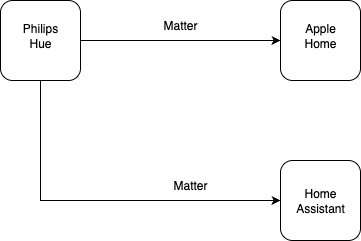Some years ago I played with Home Assistant. I really like the concept of their “bullet proof” design. Since that is what you need for home automation. But it’s still a geeky system, compared to Philips Hue or Apple Home. And that’s fine, but do I want my lights controlled, during 3 weeks holiday abroad, by such a system?
My setup uses mostly Hue lights, switches and a sensor. This is controlled by the Philips Hue bridge, which connects to Apple Home through Homekit. I think this is a setup used by many, and the configuration is very simple with the Home app. With this Apple style simplicity come the Apple style limitations. One is the result of the other. Want to turn on the lights 10 minutes earlier when the weather app says “cloudy”? Not possible.
Without Matter, the only way to integrate HA into this setup, where HA has the same control as Apple Home, is through proxying. So the Philips Hue bridge connects to the HA HomeKit integration, and HA connects to Apple Home through the HomeKit Bridge. Now HA, this geeky system, sits right in the middle of my setup. When it fails, my home automation fails. It’s on the critical path… and I don’t like that. To make things worse, HA’s HomeKit Bridge is labelled by Apple Home as a not-certified accessory…
So my HA “project” was shelved, until Matter came along. The Matter standard supports multiple “masters” in home automation. Meaning a Matter device can be controlled by two or more masters at the same time. So my abandoned proxy/serial setup could be converted into a parallel architecture, where a HA failure does not bring down my complete home automation. Taking the weather into account when turning on the lights is done by HA, and with HA down, Apple Home would still turn them on, only a little later when it’s cloudy. HA is not on the critical path anymore.
To get this configured is not difficult, but you have to get the basics right. An updated Philips Hue bridge supports Matter. For Apple Home, you need an Apple TV 4th generation. HA needs the Matter integration of course. Step one is to convert the Apple HomeKit connection between Philips Hue and Apple Home into a Matter connection. For that, go into the Philips Hue app and remove “HomeKit” under Settings -> Smart Home. Then add a new “Smart Home” connection (the + icon), but now select “Other apps”. You will see the big Matter logo. Press “get pairing code” at the bottom. Now go into the Apple Home app, tap the + icon and select “Add Accessory”. Choose “More options” and select the Hue bridge from the list to add it as a Matter device.
Check if all your devices work again in Apple Home. Most likely, you need to setup your Apple Home automations new. The process warns you that Matter might not support all device features, but I have not found any missing. Step one should result in an identical setup as before, feature wise.
Step two is the magic one. With Matter in your network, it’s shouting out its existence on the network as “_matter._tcp”. The Matter integration in HA will detect that and you go through the same pairing code process once more. After that, the Philips Hue bridge now has two entries under Settings -> Smart Home. One into Apple Home and one into HA, both using the Matter protocol.
The Matter supported power outlet switch (on WiFi) that I bought cheap in “Bauhaus” now shines: Its detected by Apple Home with one feature: power on/off. That’s the critical core feature for me. But the switch also measures grid voltage and current usage on the output. HA detects those next to the power on/off feature, and gives me a nice view of grid voltage over time.
But wait, there’s more. My Apple setup uses one apple account for me and my wife. So you have shared notes, photos and agenda, which is super helpful. But not for tailored presence detection. With the HA app, I can define accounts completely separate from the Apple ecosystem. This gives me flexibility to setup some special automations. Also I can use the HA app on an older iPad that’s not connected to iCloud. My Apple Home setup does the basic, critical stuff and HA takes care of the geeky additions, nice …


